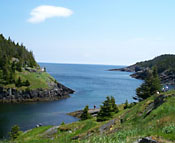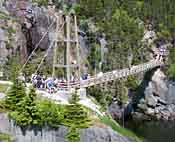La Manche Provincial Park is located approximately 53 kilometres south of St. John’s, along Highway 10. The park was first opened to the public in August 1966. This park was established because of the scenic la Manche Valley, interesting and varied habitat and vegetation, as well as the diverse bird life. The park area includes Rowsells Hill Pond, La Manche Ponds, a section of the La. Manche River, as well as the abandoned fishing village of La Manche.
Please note this map is for illustrative purposes only. The park boundary may not be accurately portrayed.
Natural History
La Manche Provincial Park contains a variety of vegetation ranging from boreal forest to peat bog and marsh. The dominant tree species are spruce, fir, larch, birch and alder. Many species of shrubs and wildflowers can be found within the park boundaries such as honeysuckle, Labrador tea, tall meadow-rue and twin flower.
Beaver, moose and snowshoe hare can be found in the park at times; mink and shrew are also present. Many species of butterfly frequent the area including mourning cloak, painted lady and common sulphur. La Manche Provincial Park is an excellent location for bird watching. To date, over 50 species of birds have been identified in the park and the following is a partial checklist. It is by no means complete so keep your eyes and ears open and see if you can spot some other species: Common Loon, American Bittern, Black Duck, Ring-necked Duck, Oldsquaw, Common Eider, Shape-shinned Hawk, Pigeon Hawk, Osprey, Common Snipe, Spotted Sandpiper, Greater Yellowlegs, Great Black-backed Gull, Herring Gull, Common Tern, Dovekie, Black Guillemot, Belted Kingfisher, Yellow-shafted Flicker, Hairy Woodpecker ,Downy Woodpecker, Yellow-bellied Flycatcher, Tree Swallow, Common Raven, Common Crow, Black-capped Chickadee, Boreal Chickadee, Red-breasted Nuthatch, Brown Creeper, American Robin, Swainson’s Thrush, Gray-cheeked Thrush, Golden-crowned Kinglet, Ruby-crowned Kinglet, Black and White Warbler, Blackpoll Warbler, Yellow Warbler, Myrtle Warbler, Black-throated Green Warbler, Northern Waterthrush, Mourning Warbler, Wilson’s Warbler, American Redstart, Rusty Blackbird, Pine Grosbeak,, Pine Siskin, Red Crossbill, White-winged Crossbill, Savannah Sparrow, Fox Sparrow, and Swamp Sparrow.
Area History
In French “La Manche” means “the sleeve”. The area is named for the shape of the harbour, which is long and narrow with high sides. This harbour was probably first used by the French because of its seclusion which offered cover between raids on Ferryland and St. John’s.

La Manche had been used as a fishing harbour for many years and was known as one of the best fishing coves on the southern shore.
The community was settled around 1840. The first settler was George Melvin, of English descent, who came from Brunt Cove, three kilometres away. He was followed shortly by relatives. La Manche remained tiny throughout its history probably because of the isolation and the rocky terrain, which hindered building homes and fish flakes (used for drying fish).
A school was built in La Manche around 1919. This school most likely only offered lower grades so children still had to go to school in Tors Cove. The La Manche school was closed after confederation (1949) since they did not have the minimum requirement of eleven students. There was no resident clergyman or doctor. A law keeper was appointed to the community but court records of that period show no mention of accused or convicted criminals.
The population of La Manche ranged from 7 to 55 over a more than 100-year span. Income was based on fishing. Farming was at subsistence level, some farm animals were kept.
In the mid-1960’s the community was under pressure to resettle into larger, nearby towns. The road leading to La Manche was difficult and expensive to maintain, particularly in the winter.
On January 25, 1966 a severe winter storm hit the east coast of the Avalon Peninsula. An enormous tide washed away all the flakes, boats, anchors and stores of La Manche as well as the suspension bridge which connected both sides of the harbour. Most of the houses were demolished, miraculously there were no deaths attributed to the storm. The entire economy of the village was destroyed so the residents of La Manche agreed to be resettled by the provincial government.

Today you can visit what remains of the village by hiking the trail that begins at the park Fire Exit Road [see map (58.8 KB)]. Generally what you will see are the house foundations of the village of La Manche. A beautiful newly constructed bridge spans the bay connecting north and south sections of the East Coast Trail.
Park Activities
Camping
La Manche Provincial Park contains 83 camping sites. Each campsite has a picnic table, fireplace, garbage can and space for your vehicle. Drinking water taps and pit toilets are conveniently located throughout the park. Firewood is available at the check point. [see map (58.8 KB)]
Day Use
The picnic or day-use area is located near the beach. Each individual site contains a picnic table and garbage can. Drinking water and pit toilets are situated nearby.
Swimming
The swimming area is in the day-use section of the park. For your convenience change houses and toilets are provided.
Caution: The swimming area is unsupervised.
Water safety equipment is located in a conspicuous place on the beach.
Hiking
The La Manche Falls Trail begins at the picnic area and runs upstream, along the La Manche River, to a waterfall. The hike can be completed in approximately one hour. Vegetation along the trail includes marsh (which is a rare habitat in Newfoundland), bog and mixed forest. Swimming is not recommended in the falls area. The La Manche Village Trail begins at the Fire Exit Road [see map (58.8 KB)]. The trail is approximately 1.25 kilometres long and the return trip takes about an hour. At the abandoned village site you can cross the bridge to travel north along the East Coast Trail system or you can travel south.
Canoeing
Canoeing on the La Manche River can be a very enjoyable way to spend the day. A convenient place to begin is from the day-use area. You can go up the river towards the falls or downstream to where the river turns into rapids, fairly close to the old village of La Manche. The route travels through marshes where the sedges and grasses are very tall. Beaver lodges can also be seen along the three kilometre route.
Services or activities in La Manche are:
- Birding
- Camping
- Hiking
- Picnic
- Swimming
Adobe® Acrobat® Reader software can be used for viewing PDF documents. Download Acrobat® Reader for free